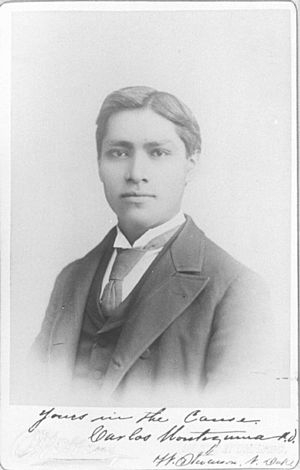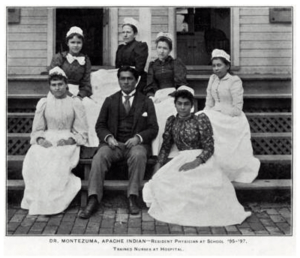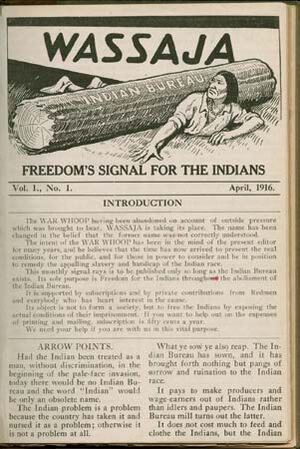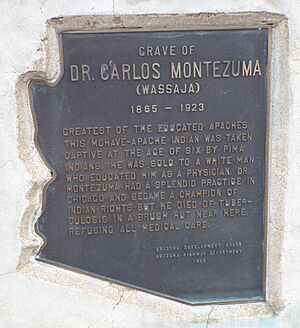Carlos Montezuma facts for kids
Quick facts for kids
Carlos Montezuma
|
|
|---|---|
| Wassaja | |

Montezuma during his career as Native American rights activist
|
|
| Born |
Wassaja
c. 1866 |
| Died | January 31, 1923 (aged 56–57) |
| Resting place | Ba Dah Mod Jo Cemetery Fort McDowell Cemetery |
| Nationality | Yavapai |
| Citizenship | United States |
| Alma mater | University of Illinois, Northwestern University |
| Occupation | Doctor |
| Known for | Native American civil rights activism |
Carlos Montezuma or Wassaja (born around 1866 – January 31, 1923) was a Yavapai-Apache Native American activist. He was also a key person in starting the Society of American Indians. His birth name, Wassaja, means "Signaling" or "Beckoning" in his native language.
When he was young, Wassaja was taken by Pima raiders along with other children to be sold. An Italian photographer named Carlo Gentile bought Wassaja in Adamsville for thirty silver dollars. Gentile gave him a new name, "Carlos Montezuma."
Carlos Montezuma made history as the first Native American student at the University of Illinois and Northwestern University. He was also the second Native American to earn a medical degree in an American university, after Susan La Flesche Picotte. Wassaja was the first Native American man to become a doctor. He spent his life fighting for the rights of his Yavapai people and other Native Americans.
Contents
Who Was Carlos Montezuma?
"I am a full-blooded Apache Indian, born around the year 1866... somewhere near Four Peaks, Arizona Territory", Dr. Montezuma wrote in 1905. His parents named him "Wassaja," meaning "signaling" or "beckoning." His father was a chief named Co-cu-ye-vah, and his mother was Thil-ge-ya.
In October 1871, when he was about five years old, Wassaja was captured by Pima raiders. He was taken to be sold. He was brought to Adamsville, a village with both Anglo and Mexican people. There, an Italian photographer named Carlo Gentile bought him for thirty silver dollars. Gentile was in the area doing research on Native Americans.
Gentile was a kind and educated man from Naples who had moved to America. He adopted Wassaja as his son. He renamed him "Carlos Montezuma" to honor the child's heritage. The name "Montezuma" came from the ancient Montezuma ruins near Adamsville.
His Early Life and Travels

For the next few years, Wassaja (now Carlos) traveled with his adoptive father. They went on photography and research trips in Arizona, New Mexico, and Colorado. For a few months in 1872–73, they even joined a theater group. This group included Ned Buntline and Buffalo Bill.
Young Wassaja performed as Azteka, the Apache-child of Cochise in a play called The Scouts of the Prairie. They performed in big cities like Chicago, St. Louis, and New York. During this time, Gentile sold promotional photos of the actors.
How He Got His Education
Gentile and Montezuma lived in Chicago and then New York for some years. In 1877, Gentile lost everything in a fire. This forced him to return to his traveling work and then to Chicago. Wassaja was homeschooled by Gentile and went to public schools in different cities. He was a very dedicated and smart student.
Gentile realized Wassaja needed a more stable place to finish his education. In 1878, he asked for help from the Reverend George W. Ingalls. Wassaja was placed with a Baptist minister, William H. Steadman, in Urbana, Illinois. Gentile then focused on rebuilding his photography business in Chicago.
Carlos was a very bright child and focused completely on his studies. He graduated with honors from Urbana High School in 1879. After one more year of preparation, he started at the University of Illinois in 1880. He was only fourteen years old.
At the University of Illinois, he studied many subjects, including English, math, German, and science. He was especially good at chemistry. Montezuma, or "Monte" as his classmates called him, also began speaking out for Native American rights. In 1883, he gave a speech called Indian's Bravery where he compared Native Americans to brave Spartans.
Becoming a Doctor
After graduating from the University of Illinois in 1884, Montezuma went back to Chicago. He earned his medical degree from the Chicago Medical College in 1889. This college was part of Northwestern University. He got his license to practice medicine that same year.
Montezuma was not only the first Native American student at both the University of Illinois and Northwestern University. He was also the second Native American ever to earn a medical degree in an American university. The first was Susan La Flesche Picotte, who also graduated in 1889. Wassaja was the first Native American man to become a doctor.
Working for Native American Affairs
As early as 1887, Carlos Montezuma had been writing to Richard Henry Pratt. Pratt was a strong supporter of Native Americans blending into American society. He also founded the Carlisle Indian School in Pennsylvania. Pratt saw Montezuma as a great example of what educated Native Americans could achieve.
In 1887, Montezuma was asked to speak in New York and Philadelphia about this topic. Because of these connections, after he graduated, he was offered a job as a doctor with the Bureau of Indian Affairs (BIA). In 1889, Montezuma traveled to reservations in Dakota Territory to help Native Americans. He later moved to Nevada and Washington for his work.
In July 1893, he went to the Carlisle Indian Industrial School in Pennsylvania. Here, Montezuma worked with his mentor, Richard Henry Pratt. His experiences working on reservations and with Pratt helped him form his early ideas about how the government should treat Native Americans.
Returning to His Roots
On October 27, 1893, Wassaja's adoptive father, Carlo Gentile, passed away in Chicago. Montezuma had visited Gentile a few months earlier. Since he was in Pennsylvania, Montezuma could not attend the funeral. He helped Gentile's widow financially and even cared for Gentile's six-year-old son for a while.
In early 1896, Dr. Montezuma left Pratt and returned to Chicago to start his own medical practice. In 1900, he went back to Arizona for the first time since he was a child. He traveled as the team doctor for Coach Pop Warner's football team from the Carlisle Indian School.
The next year, he visited Arizona again on his own. He found long-lost relatives he had not seen since he was taken as a child. Montezuma had disliked the reservation system. But his feelings changed when he saw how deeply his people were connected to their ancestral land. He realized they considered it their true home.
After this, he joined the Yavapai people's fight. This led to the creation of the Fort McDowell Yavapai or Mohave-Apache Reservation by late 1903. Until his death, he fought to support the rights of his people on the reservation. In 1904, Dr. Montezuma started the Indian Fellowship League in Chicago. This was the first organization for Native Americans in a U.S. city.
By 1905, Carlos Montezuma was known nationally as a Native American leader. He began speaking out against the government for the poor conditions faced by Native Americans. He became a strong opponent of the Bureau of Indian Affairs (BIA).
In 1911, he helped create the Society of American Indians. This was the first Native American rights group started by and for Native Americans. In 1916, he began a monthly magazine called Wassaja. He used this magazine to share his views on the BIA, Native American education, civil rights, and citizenship.
Dr. Montezuma became very sick with tuberculosis in 1922. He decided to return permanently to his people's land. He passed away on January 31, 1923, and is buried at the Fort McDowell Indian cemetery. His work was largely forgotten until the 1970s, when historians rediscovered his important achievements.
What Is Carlos Montezuma's Legacy?
The Fort McDowell Yavapai Nation honored Carlos Montezuma in 1996. They named their new health care center the Dr. Carlos Montezuma, Wassaja Memorial Health Center. In 2015, the University of Illinois announced that its newest residence hall would be named in his honor. This naming included meetings with the Peoria tribe to improve relations with Native Americans on campus.
See also
 In Spanish: Carlos Montezuma para niños
In Spanish: Carlos Montezuma para niños




